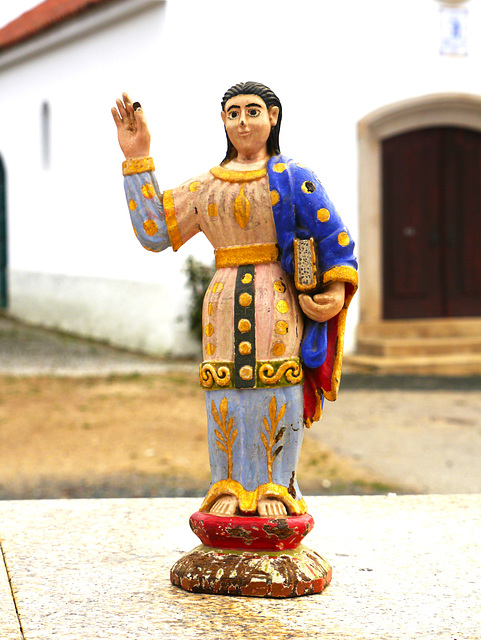HFF
Rio da Mula
HBM
Chaves
Sala da Caça - Mafra
Mafra - Its books
HFF
Guincho
HBM
The raining still goes on.
Sortelha
HFF
Rio da Mula - Canard
HBM
Husband
Arc boutants
Monsanto
HFF
Frenzy
HBM
Faith
Sintra
HFF
Barcelona
HBM
African Sunday.
Red
HFF
Mertola
Stay with the family, I say.
Freedom II
Love
Only 50 were made.
HFF
Four Happy Birthdays
Setúbal
Dinner time
HBM
Sculpture II - PIP Please
Ladies first
HFF
Guincho
HBM
Ericeira
I am sweet
See also...
See more...Keywords
Authorizations, license
-
Visible by: Everyone -
All rights reserved
-
73 visits
Santon


Santons (Provençal: "santoun," or "little saint") are small hand-painted terracotta nativity scene figurines produced in the Provence region of southeastern France. In a traditional Provençal crèche, there are 55 individual figures representing various characters from Provençal village life such as the scissors grinder, the fishwife, the blind man, and the chestnut seller.
The first clay santons were created by Marseillais artisan Lagnel (1761-1822) during the French Revolution when churches were forcibly closed and their large nativity scenes prohibited. Lagnel crafted small figurines in plaster molds and let them dry before firing them.
A maker of "santons" is a santonnier, and the creation of santons today is essentially a family craft, handed down from parents to children. Santons are molded in two halves, pressed together, and fused. Hats, baskets, and other accessories are applied with an adhesive. When the figure is completely dry, it is given a gelatin bath in order to harden the figure further and to provide a surface for the application of pigments. Faces are painted first, then hair, clothing, and accessories. Until the end of the 19th century, santons were air-dried rather than fired in a kiln. As a consequence, such figures were fragile and easily broken because of lack of strength. Modern santons are generally fired in a kiln. There are two types of santons: santons d'argile (clay figures), and doll-like santons habillés (clothed figures).
Since 1803, santonniers have gathered in Marseille each December to display and sell their wares at the Foire des Santonniers. Aubagne Santon Fair in Marseille holds a two-day fair, Biennale de l'Art Santonnier, and the Musée du Santon in Marseille exhibits a private collection of 18th and 19th century santons.
The first clay santons were created by Marseillais artisan Lagnel (1761-1822) during the French Revolution when churches were forcibly closed and their large nativity scenes prohibited. Lagnel crafted small figurines in plaster molds and let them dry before firing them.
A maker of "santons" is a santonnier, and the creation of santons today is essentially a family craft, handed down from parents to children. Santons are molded in two halves, pressed together, and fused. Hats, baskets, and other accessories are applied with an adhesive. When the figure is completely dry, it is given a gelatin bath in order to harden the figure further and to provide a surface for the application of pigments. Faces are painted first, then hair, clothing, and accessories. Until the end of the 19th century, santons were air-dried rather than fired in a kiln. As a consequence, such figures were fragile and easily broken because of lack of strength. Modern santons are generally fired in a kiln. There are two types of santons: santons d'argile (clay figures), and doll-like santons habillés (clothed figures).
Since 1803, santonniers have gathered in Marseille each December to display and sell their wares at the Foire des Santonniers. Aubagne Santon Fair in Marseille holds a two-day fair, Biennale de l'Art Santonnier, and the Musée du Santon in Marseille exhibits a private collection of 18th and 19th century santons.
Jocelyne Villoing, Roger (Grisly), Ulrich John, Marco F. Delminho and 10 other people have particularly liked this photo
- Keyboard shortcuts:
Jump to top
RSS feed- Latest comments - Subscribe to the comment feeds of this photo
- ipernity © 2007-2024
- Help & Contact
|
Club news
|
About ipernity
|
History |
ipernity Club & Prices |
Guide of good conduct
Donate | Group guidelines | Privacy policy | Terms of use | Statutes | In memoria -
Facebook
Twitter

www.ipernity.com/group/churches
Sign-in to write a comment.